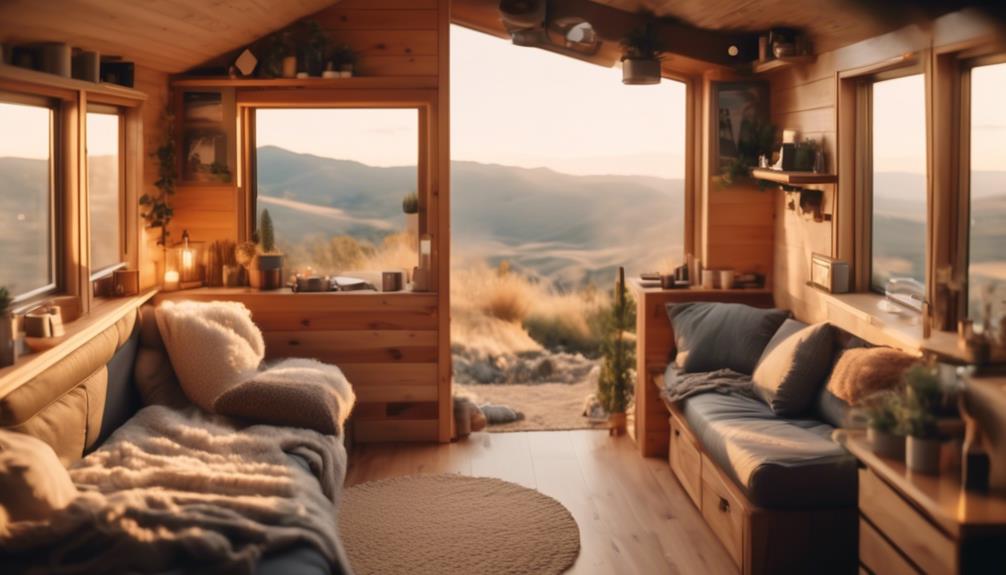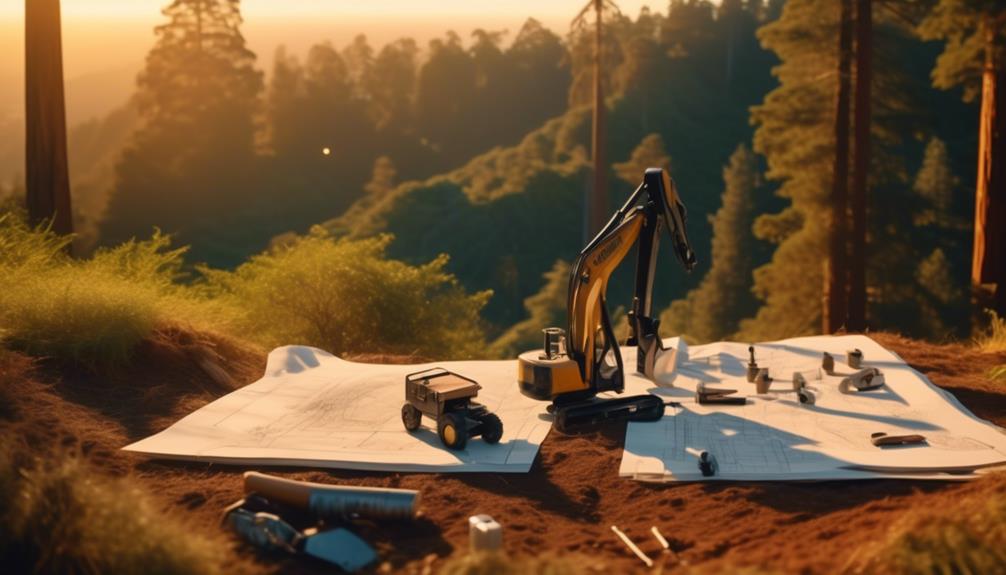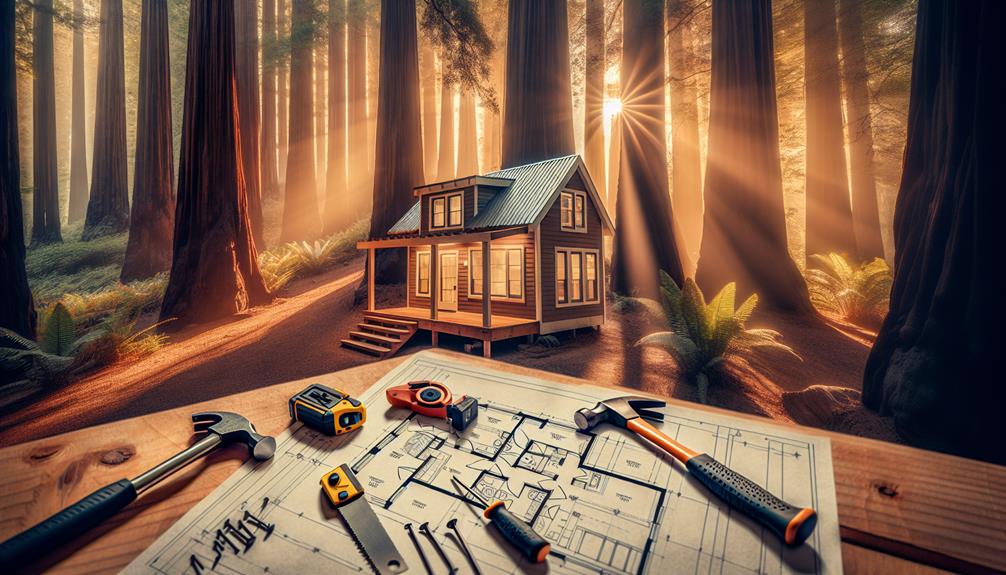You might not be aware, but California's shifting legislative landscape offers new possibilities for tiny home enthusiasts like you. With a growing interest in sustainable living and affordable housing, you're looking at a state that has been paving the way for tiny home construction through laws like SB9, which allows property division for additional housing units.
As you contemplate the blueprint of your dream micro dwelling, bear in mind that each city in California comes with its own set of zoning laws and building codes that can significantly influence your project's trajectory. You'll need to navigate these regulations carefully to ensure your tiny home isn't just a castle in the air.
Stay with us as we unpack the intricate tapestry of legalities and practicalities that will help you transform your tiny house vision into a concrete reality nestled in the Golden State's diverse landscapes.
Key Takeaways
- Familiarize yourself with local zoning laws and regulations for tiny home construction in California.
- Ensure compliance with both zoning regulations and California Building Codes (CBC) when constructing a tiny home.
- Consult with local zoning authorities and construction experts for guidance throughout the construction process.
- Explore off-grid options and sustainable living practices to reduce reliance on traditional utilities and promote environmental sustainability.
Understanding Zoning Laws
To legally construct a tiny home in California, you must first understand the zoning laws that govern your property's location. Local zoning ordinances vary by city, making it crucial to consult with your local planning department.
These zoning regulations may classify tiny homes as accessory dwelling units (ADUs), which are often subject to specific lot sizes, setbacks, and usage restrictions under both local and state law.
Ensuring compliance with zoning and building regulations, as set forth by the California Building Standards Commission, is imperative to avoid legal pitfalls.
As you navigate the intricate landscape of residential zones, seeking advice from zoning authorities or legal experts can provide clarity and ensure that your innovative tiny home project aligns with all legal requirements.
California Building Codes
As you navigate the construction of your tiny home in California, adhering to the California Building Codes (CBC) is paramount. The recent SB9 bill has streamlined the process, allowing the creation of up to four living units on a single property, which can include tiny homes as ADUs.
To ensure your tiny home project is above board, it's critical to comply with both the CBC and local zoning regulations that impact where and how you can build.
Compliance With State Standards
Ensuring your tiny home meets California Building Codes is a fundamental step in the construction process to guarantee both legality and safety.
When building a tiny home in California, you must navigate through various rules and regulations, ensuring your dwelling aligns with the stringent requirements set forth by the state. This includes registering your abode as an accessory dwelling unit (ADU) and adhering to all zoning regulations.
To achieve compliance with state standards, it's essential to secure the necessary building permits. Consult local zoning authorities and construction experts familiar with California Tiny House Laws to guide you through this intricate process.
Zoning Regulations Impact
While you work to align your tiny home with California Building Codes, it's equally crucial to understand how local zoning regulations will shape your construction project.
In California, zoning can either foster or hinder your plans for building tiny homes. Being classified as accessory Dwelling Units (ADUs), especially those over 400 square feet, can streamline the process. Thanks to legislation like SB9, you now have the opportunity to divide your property into up to four units, making tiny houses legal and more feasible.
Before you park your tiny home or join tiny home communities, consult with local authorities to grasp the specific zoning requirements. Registering with CBC and meeting ADU standards is a must for legal recognition. Remember, each city and county may have unique regulations, and staying informed is key to a compliant tiny home build.
Designing Your Tiny Home

When designing your tiny home, it's essential to balance space-efficiency with a comfortable and functional living environment. Here's how you can maximize your tiny home's potential in California:
- Compliance: Ensure your design meets California's zoning laws to allow tiny homes on wheels or stationary foundations.
- Layout: Optimize the floor area by creating an open floor plan with multi-functional furniture, maximizing square feet usage.
- Sustainability: Incorporate energy-efficient features to reduce your ecological footprint and living costs.
- Storage: Plan for innovative storage solutions that utilize vertical space and hidden compartments.
Living in a tiny home community or independently requires innovative design strategies. By focusing on these key aspects, you'll create a tiny haven that's both sustainable and suits your lifestyle.
Permitting Process Simplified
How does one navigate the streamlined permitting process for constructing a tiny home in California?
First, you'll want to check the local city and county regulations for tiny homes. These rules will guide you in meeting the California Department of Housing requirements. When building a tiny house, obtaining a permit through the planning department is crucial. You may need to adhere to lot size or setback restrictions.
Recent legislation like SB9 simplifies this by allowing property division for additional units, easing the way for tiny homes. Register your tiny house with the California Building Codes to ensure it's legal. Cities like Los Angeles and San Diego have a permitting process simplified for tiny homes, indicating a supportive stance.
Getting a special permit or connecting with local authorities will be your next step.
Site Planning and Preparation

Before you lay the first board of your tiny home, selecting the ideal location within California is crucial, adhering to zoning laws and ensuring the site meets size requirements.
You'll need to prepare the groundwork, which includes conducting soil tests, percolation tests for septic systems, and obtaining necessary inspections to comply with the state's Climatic and Geographic Design Criteria.
Additionally, setting up utilities is a key step, involving coordination for water, electricity, and waste management hookups in compliance with local regulations.
Selecting Ideal Location
Selecting the ideal location for your tiny home in California requires a thorough understanding of local regulations and a strategic approach to site planning and preparation. When you're looking for land, consider these steps to find the best spot for your Tiny Living dream:
- Research communities in California for their openness to Living Tiny; regulations can vary based on the area.
- Consult with county or city officials to understand zoning laws and whether they permit tiny homes, especially in desired locations like Los Angeles.
- Factor in property taxes and the cost of utilities, which can impact your budget.
- Partner with a real estate agent familiar with local ordinances to pinpoint land that meets your needs and complies with regulations.
Your diligence will pave the way for a successful tiny home setup in the Golden State.
Groundwork and Utilities Setup
Having pinpointed the ideal location for your tiny home, it's crucial to focus on the groundwork and utilities setup to ensure your site is ready for construction.
When planning to build, make sure the land is primed for proper drainage, leveling, and a solid foundation—key steps in building a stable and durable tiny home.
Your utilities setup must meet local regulations, including connections for water, electricity, and waste management. In California, considering solar panels could align with your innovative vision and eco-friendly goals.
Consult with experts to navigate these initial stages; their guidance will be invaluable.
A tiny home must have its site and utilities precisely prepared to comply with legal and safety standards before you put a tiny house on your chosen spot.
Tiny Home Utilities Setup
When setting up utilities for your tiny home in California, you'll need to connect to water, sewer, and electrical services, often requiring permits from local authorities. Here's what you need to know:
- Investigate local zoning laws to understand utility connection requirements and impact fees.
- Consider off-grid options like solar panels and composting toilets to reduce your cost of living.
- If you live in a tiny house community, ensure you're compliant with shared utility setups.
- Learn more about Tiny home utilities setup for both urban and rural settings, including alternative systems.
As you navigate the process, remember that innovative solutions can make tiny living sustainable and efficient. Whether you're looking at tiny homes for sale or building your own, a well-thought-out utilities setup is crucial.
Frequently Asked Questions
What Are the Rules for Tiny Houses in California?
You must navigate zoning restrictions, adhere to ADU regulations, and meet foundation requirements. Comply with building codes, follow permit processes, consider vehicle classification, plan sewage solutions, observe loft regulations, ensure minimum square footage, and uphold fire safety standards.
How Much Does It Cost to Build a Tiny House in California?
You'll spend $25,000 to $150,000 building your tiny house, with design budget, material costs, and square footage affecting expenses. Consider DIY savings, local builders, financing options, sustainability incentives, and resale value during your construction timeline.
Can I Build a Tiny House on Vacant Land in California?
You can build a tiny house on vacant land, but you'll face zoning challenges, navigate a complex permitting process, meet foundation requirements, and ensure utility connections, land grading, and minimal environmental impact. Consider property taxes and resale.
How to Start Building Tiny Homes?
You'll face zoning challenges initially, but find design inspiration and sustainable materials to overcome them. Attend DIY workshops, maximize space optimization, secure building permits, establish utility connections, choose contractors, select custom features, and explore financing options.
Conclusion
Well, you've nearly made it through the labyrinth of California's tiny home construction! Just remember, while you're squeezing your dreams into a pint-sized palace, bureaucrats are busy crafting regulations that could fill a mansion.
Dot every 'i' and cross every 't', because in the Golden State, even your miniature abode must meet the grandeur of building codes.
Here's to hoping your tiny home isn't just a glorified blueprint by the time you're done! Keep it precise, keep it compliant, and good luck!

